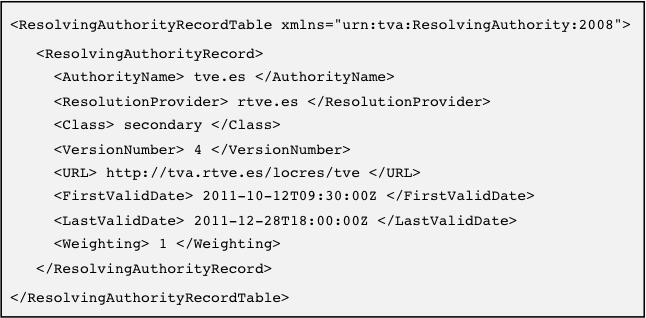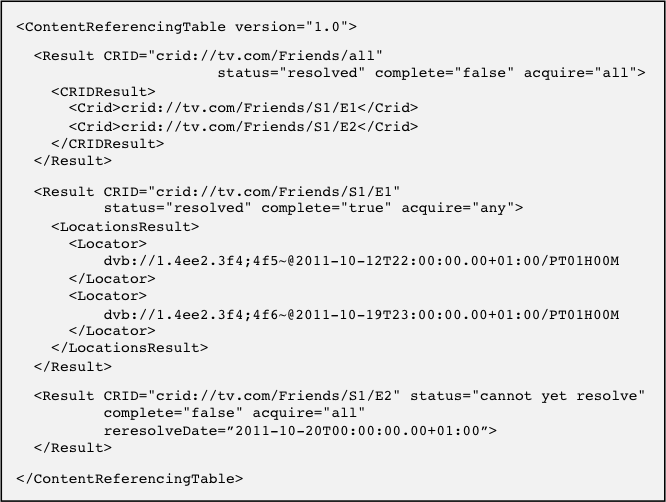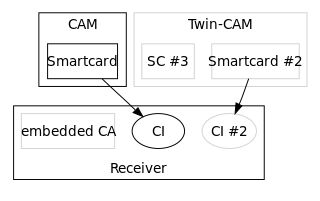This article may be in need of reorganization to comply with Wikipedia's layout guidelines .(April 2013) |
This article may be in need of reorganization to comply with Wikipedia's layout guidelines .(April 2013) |
A content reference identifier or CRID is a concept from the standardization work done by the TV-Anytime forum. It is or closely matches the concept of the Uniform Resource Locator, or URL, as used on the World-Wide Web:
A unit of content, in a broadcast stream, can be referred to by its globally unique CRID in the same way that a webpage can be referred to by its globally unique URL on the web.
The concept of CRID permits referencing contents unambiguously, regardless of their location, i.e., without knowing specific broadcast information (time, date and channel) or how to obtain them through a network, for instance, by means of a streaming service or by downloading a file from an Internet server.
The receiver must be capable of resolving these unambiguous references, i.e. of translating them into specific data that will allow it to obtain the location of that content in order to acquire it. This makes it possible for recording processes to take place without knowing that information, and even without knowing beforehand the duration of the content to be recorded: a complete series by a simple click, a program that has not been scheduled yet, a set of programs grouped by a specific criterion…
This framework allows for the separation between the reference to a given content (the CRID) and the necessary information to acquire it, which is called a “locator”. Each CRID may lead to one or more locators which will represent different copies of the same content. They may be identical copies broadcast in different channels or dates, or cost different prices. They may also be distinct copies with different technical parameters such as format or quality.
It may also be the case that the resolution process of a CRID provides another CRID as a result (for example, its reference in a different network, where it has an alternative identifier assigned by a different operator) or a set of CRIDs (for instance, if the original CRID represents a TV series, in which case the resolution process would result in the list of CRIDs representing each episode).
From the above it can be concluded that provided that a given content can belong to many groups (each possibly defined by distinctive qualities), it is possible that many CRIDs carry the same content. That is, several CRIDs may be resolved into the same locator.
A CRID is not exactly a universal, unique and exclusive identifier for a given content. It is closely related to the authority that creates it, to the resolution service provider, and to the content provider in such a way that the same content may have different CRIDs depending on the field in which they are used (for example, a different one for each television operator that has the rights to broadcast the content).
A CRID is specified much like URLs. In fact, a CRID is a so-called URI. Typically, the content creator, the broadcaster or a third party will use their DNS-names in a combination with a product-specific name to create globally unique CRIDs. That is, the syntax of a CRID is:
crid://authority/data
The authority field represents the entity that created the CRID and its format is that of a DNS name. The data field represents a string of characters that will unambiguously identify the content within the authority scope (it is a string of characters assigned by the authority itself).
As an example, let's assume that BBC wanted to make a CRID for (all the programs of) the Olympics in China. It may have looked something like this
crid://bbc.co.uk/olympics/2008/
This would be a group CRID, that is, a CRID representing a group of contents. Then, to refer to a specific event – such as the women's shot-put final – they could have used the following inside their metadata.
crid://bbc.co.uk/olympics/2008/final/shotput/women
Currently,[ when? ] four types of CRIDs are playing a major role in some unidirectional television networks: programme CRID, series CRID, group CRID, and recommendation CRID. One of the most important applications of CRIDs is the so-called series link recording function (SL) of modern digital video recorders (DVR, PVR).
In turn, a locator is a string of characters that contains all the necessary information for a receiver to find and acquire a given content, whether it is received through a transport stream, located in local storage, downloaded as a file from an Internet server, or through a streaming service. For example, a DVB locator will include all the necessary parameters to identify a specific content within a transport stream: network, transport stream, service, table and/or event identifiers.
The locators' format, as established in TV-Anytime, is quite generic and simple, and corresponds to:
[transport-mechanism]:[specific-data]
The first part of the locator’s format (the transport mechanism) must be a string of characters that is unique for each mechanism (transport stream, local file, HTTP Internet access…). The second part must be unambiguous only within the scope of a given transport mechanism and will be standardized by the organism in charge of the regulation of the mechanism itself. For instance, a DVB locator to identify a content within the transport stream of networks that follow this standard would be:
dvb://112.4a2.5ec;2d22~20121212T220000Z—PT01H30M
which would indicate a content (identified by the string “2d22”) that airs on a channel available on a DVB network identified by the address “112.4a2.5ec” (network “112”, transport stream “4a2” and service “5ec”), on 12 December 2012 at 10 p.m. and with a duration of 90 minutes.
The location resolution process is the procedure by which, starting from the CRID of a given content, one or several locators of that content are obtained. Resolving a CRID can be a direct process, which leads immediately to one or many locators, or it may also happen that in the first place one or many intermediate CRIDs are returned, which must undergo the same procedure to finally obtain one or several locators.
This procedure involves some information elements, among which we find two structures named resolving authority record (RAR) and ContentReferencingTable, respectively. Consulting them repeatedly will take the receiver from a CRID to one or many locators that will allow it to acquire the content.
The RAR table
The RAR table is one or many data structures that provide the receiver, for each authority that submits CRIDs, information on the corresponding resolution service provider. Among other things, it informs about which mechanism is used to provide information to resolve the CRIDs from each authority. That is, one or many RAR records must exist for each authority that indicate the receiver where it has to go to resolve the CRIDs of that particular authority.
For example, in the record of the figure (expressed by means of a XML structure, according to the XML Schema defined in the TV-Anytime) there is an authority called “tve.es”, whose resolution service provider is the entity “rtve.es”, available on the URL "http://tva.rtve.es/locres/tve", which means there is resolution information in that URL.

These RAR records will have reached the receiver in an indefinite form, unimportant for the TV-Anytime specification, which will depend on the specific transport mechanism of the network to which the receiver is connected. Each family of standards that regulates distribution networks (DVB, ATSC, ISDB, IPTV...) will have previously defined such procedure, which will be used by devices certified according to those standards.
The ContentReferencingTable table
The second structure involved in the location resolution process is a proper resolution table which, given a content's CRID, returns one or several locators that enable the receiver to access an instance of that content, or one or many CRIDs that allow it to move forward in the resolution process.
The figure shows an example of this second structure, an XML document according to the specifications of the XML Schema defined in TV-Anytime. In it, several sections are included (<Result> elements) that structure the information that describes each resolution case.

The first one declares how a CRID (crid://tv.com/Friends/all), which corresponds to a group content that encompasses several episodes (two) of the “Friends” series is resolved. The result of the resolution process provides two new CRIDs each of them corresponding to one of the two episodes.
The second <Result> element resolves the CRID of the first episode of the first season. The result of the resolution process is two DVB locators. The “acquire” attribute with “any” value indicates that any of them are good (the second one is a repetition broadcast a week later).
The third <Result> element gives information about the second episode. It indicates that it cannot be resolved yet (“status” attribute with the “cannot yet resolve” value), indicating a date on which the request for resolution information must be repeated.
The process
Once the user has selected a given content (identified by the corresponding CRID) to perform some action upon it, the receiver begins the location resolution process that shall lead to specific location information that allows access to a copy of the content.
This procedure depends mainly on the receiver’s connectivity. It is possible to make a basic distinction between unidirectional networks, where the receiver can only receive information through the broadcast channel, and bidirectional networks, where there is also a return channel through which the receiver can communicate with the outside (typically an Internet access).
For receivers connected only to a broadcast channel, it is clear that the resolution information must come directly from that channel, or be available somehow in an existing local storage system. After selecting a CRID, the first thing the receiver needs to do is check the information about where to find the resolution table. For this, it must find a RAR record associated with the authority of the selected CRID.
Once a RAR record corresponding to that authority is found, the receiver will know, by referring to the URL field, where to access (or, in this case, where to listen) to obtain the resolution information.
The information that will receive through that access point will consist of a message for each of the consulted CRIDs (for example, a <Result> element in the ContentReferencingTable).
To make the CRID even more globally available the IETF will publish a request for comments specifying the use of the CRID over the web. This will allow consumer devices to hook up to content provider servers, much like current browsers look up webservers, requesting content by CRID.
In May 2005, an Informational RFC, No 4078, was published as the start of this work.
The long-term goal is that CRIDs should be available for use by cell phones, PDAs, digital TV receivers and other consumer devices for fetching content, either from a broadcast stream or over IP networks.

In computer networking, multicast is group communication where data transmission is addressed to a group of destination computers simultaneously. Multicast can be one-to-many or many-to-many distribution. Multicast should not be confused with physical layer point-to-multipoint communication.
DigiCipher 2, or simply DCII, is a proprietary standard format of digital signal transmission and it doubles as an encryption standard with MPEG-2/MPEG-4 signal video compression used on many communications satellite television and audio signals. The DCII standard was originally developed in 1997 by General Instrument, which then became the Home and Network Mobility division of Motorola, then bought by Google in Aug 2011, and lastly became the Home portion of the division to Arris.
DVB-T, short for Digital Video Broadcasting – Terrestrial, is the DVB European-based consortium standard for the broadcast transmission of digital terrestrial television that was first published in 1997 and first broadcast in Singapore in February, 1998. This system transmits compressed digital audio, digital video and other data in an MPEG transport stream, using coded orthogonal frequency-division multiplexing modulation. It is also the format widely used worldwide for Electronic News Gathering for transmission of video and audio from a mobile newsgathering vehicle to a central receive point. It is also used in the US by Amateur television operators.

Advanced Television Systems Committee (ATSC) standards are an American set of standards for digital television transmission over terrestrial, cable and satellite networks. It is largely a replacement for the analog NTSC standard and, like that standard, is used mostly in the United States, Mexico, Canada, and South Korea. Several former NTSC users, such as Japan, have not used ATSC during their digital television transition, because they adopted other systems such as ISDB developed by Japan, and DVB developed in Europe, for example.
A broadcast flag is a bit field sent in the data stream of a digital television program that indicates whether or not the data stream can be recorded, or if there are any restrictions on recorded content. Possible restrictions include the inability to save an unencrypted digital program to a hard disk or other non-volatile storage, inability to make secondary copies of recorded content, forceful reduction of quality when recording, and inability to skip over commercials.
Broadcasttelevision systems are the encoding or formatting systems for the transmission and reception of terrestrial television signals.
Pirate decryption is the decryption, or decoding, of pay TV or pay radio signals without permission from the original broadcaster. The term "pirate" is used in the sense of copyright infringement. The MPAA and other groups which lobby in favour of intellectual property regulations have labelled such decryption as "signal theft" even though there is no direct tangible loss on the part of the original broadcaster, arguing that losing out on a potential chance to profit from a consumer's subscription fees counts as a loss of actual profit.
Datacasting is the broadcasting of data over a wide area via radio waves. It most often refers to supplemental information sent by television stations along with digital terrestrial television (DTT), but may also be applied to digital signals on analog TV or radio. It generally does not apply to data which is inherent to the medium, such as PSIP data which defines virtual channels for DTT or direct broadcast satellite systems; or to things like cable modem or satellite modem, which use a completely separate channel for data.
MPEG transport stream or simply transport stream (TS) is a standard digital container format for transmission and storage of audio, video, and Program and System Information Protocol (PSIP) data. It is used in broadcast systems such as DVB, ATSC and IPTV.
Conditional access (CA) is a term commonly used in relation to software and to digital television systems. Conditional access is that ‘just-in-time’ evaluation to ensure the person who is seeking access to content is authorized to access the content. Said another way, conditional access is a type of access management. Access is managed is by requiring certain criteria to be met before granting access to the content.

In Digital Video Broadcasting, the Common Interface is a technology which allows decryption of pay TV channels. Pay TV stations want to choose which encryption method to use. The Common Interface allows TV manufacturers to support many different pay TV stations, by allowing to plug in exchangeable conditional-access modules (CAM) for various encryption schemes.
IP multicast is a method of sending Internet Protocol (IP) datagrams to a group of interested receivers in a single transmission. It is the IP-specific form of multicast and is used for streaming media and other network applications. It uses specially reserved multicast address blocks in IPv4 and IPv6.
TV-Anytime is a set of specifications for the controlled delivery of multimedia content to a user's local storage. It seeks to exploit the evolution in convenient, high capacity storage of digital information to provide consumers with a highly personalized TV experience. Users will have access to content from a wide variety of sources, tailored to their needs and personal preferences. TV-Anytime specifications are specified by the TV-Anytime Forum.

Freeview is New Zealand's free-to-air television platform. It is operated by a joint venture between the country's major free-to-air broadcasters – government-owned Television New Zealand and Radio New Zealand, government-subsidised Whakaata Māori, and the American-owned Warner Bros. Discovery.
ATSC-M/H is a U.S. standard for mobile digital TV that allows TV broadcasts to be received by mobile devices.

A free-to-air or FTA Receiver is a satellite television receiver designed to receive unencrypted broadcasts. Modern decoders are typically compliant with the MPEG-2/DVB-S and more recently the MPEG-4/DVB-S2 standard for digital television, while older FTA receivers relied on analog satellite transmissions which have declined rapidly in recent years.
Service Description Table (SDT) is a metadata table used in Digital Video Broadcasting systems to describe the television, radio or other services contained in MPEG transport streams provided by the system. The purpose and format of the table is defined in ETSI EN 300 468: Specification for Service Information (SI) in DVB systems.
A Web-to-TV installation provides a way to show streaming television or other over-the-top content from the Internet, to a television set. Various technologies to do this include Home theater PCs, digital media receivers, and Smart TVs.

DVB 3D-TV is a new standard that partially came out at the end of 2010 which included techniques and procedures to send a three-dimensional video signal through actual DVB transmission standards. Currently there is a commercial requirement text for 3D TV broadcasters and Set-top box manufacturers, but no technical information is in there.
The Entertainment Identifier Registry, or EIDR, is a global unique identifier system for a broad array of audio visual objects, including motion pictures, television, and radio programs. The identification system resolves an identifier to a metadata record that is associated with top-level titles, edits, DVDs, encodings, clips, and mash-ups. EIDR also provides identifiers for video service providers, such as broadcast and cable networks.